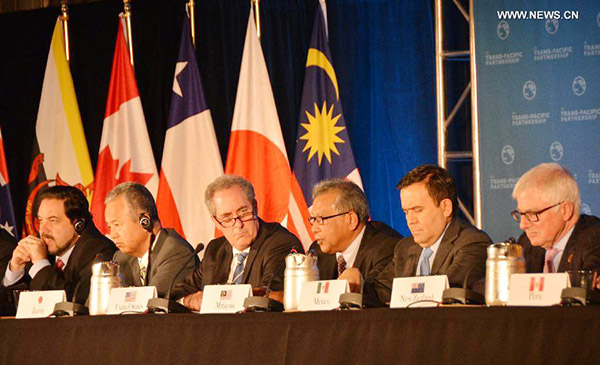China reluctant to join "the 'anyone but China' club"
By Robert W. McGee and Yeomin Yoon | chinadaily.com.cn | Updated: 2015-10-30 18:02
 |
| Trade ministers of the United States and 11 other Pacific Rim countries attend a press conference after negotiating the Trans-Pacific Partnership (TPP) trade agreement in Atlanta, the United States, on Oct. 5, 2015. [Photo/Xinhua] |
On its October 11 opinion page, the New York Times carried a cartoon showing a roadside scene where a person resembling China's President Xi Jinping is sitting in a car - dubbed "China's Economy" and driven to a ditch - and checking a roadmap with a grim face, while a person who looks like US President Barack Obama happily waves his hand through the window of his vehicle dubbed "TPP Trade Deal". The caption accompanying the cartoon read: "The trade deal could decrease Asia's reliance on China's slowing economy. Could the Trans-Pacific Partnership sideline China in Asia?"
The author of the cartoon appears to convey two messages to his readers: first, China's economy has been driven into a ditch; second, the TPP excludes China. The first message is blatantly inaccurate and unfair. Neither the recent volatility of China's stock markets nor the slower growth rate of its gross domestic product means China's economy has been driven into a ditch. In fact, it was the US economy that was driven to such a pitiful state as an aftermath of its financial crisis in 2008. The second message is literally true; China has neither been invited nor invited itself to join the US-initiated TPP.
Aside from its accuracy and fairness depicting reality, the cartoon seems to reflect fairly well the understanding as well as the sentiment of the general public in the US regarding the TPP, which is: The US-initiated treaty would serve as "an important counterweight to Chinese ambitions for US allies". In a recent editorial, the Milwaukee Wisconsin Journal Sentiment, a typical US newspaper catering to middle America, proclaimed that "by linking the US tightly with the Pacific rim, the treaty helps give allies in the region a choice, a key element of President Barack Obama's 'pivot' to Asia." This editorial faithfully echoes Obama's earlier statement: "When more than 95 percent of our potential customers live outside our borders, we can't let countries like China write the rules of the global economy".
Two legitimate and pertinent questions arise: First, does it make sense economically and ethically to exclude China, the largest trading nation in the world, from a regional trade agreement involving Asia? The answer seems too obvious to elaborate. Second, what should/can China do? David Pilling, an influential columnist for the Financial Times, argues that "China should call everyone's bluff by starting negotiations … to be inside the TPP tent".
The Southern Metropolis Daily in China also argues that China should "embrace the TPP" so as to instill a greater sense of urgency in kick-starting the nation's economic transformation from state-led manufacturing to private-led services. Such arguments provoke the following rhetorical question: Would a man with self-respect invite himself to a party if the host does not want to invite him? It seems undignified if China attempts to join "the 'anyone but China' club".
The best strategy for China would be to sidestep what looks like "the economic complement to Washington's military pivot to Asia", or "the economic NATO" attempting to contain China's influence in Asia, and instead press ahead with another new regional trade agreement, the 21-member Free Trade Area of Asia Pacific (FTAAP), which includes all TPP countries and other trading powers such as China and South Korea.
The concept of FTAAP, which is more inclusive than the 12-member TPP, has been around for about a decade. It has been studied by various think tanks and academics but needs a champion who is willing take the initiative to start negotiations. China, the largest trading nation and second largest economy in the world, can play such a role. According to a credible economic study, income gains that would arise from the FTAAP would be eight times as large as those from the TPP by 2025.
If the US balked at China's leading role in the FTAAP, China would be able to press ahead with a second best trade treaty, the Regional Comprehensive Economic Partnership (RCEP), which excludes the US, Canada, Mexico, Chile and Peru but includes India, Cambodia, Laos and Myanmar. The income gain expected from the 16-member RCEP (or 20-member RCEP if Russia, Taiwan, Hong Kong, and Papua New Guinea were included) would be almost three times as large as that of the TPP. In addition, China's Belt and Road Initiative is more consistent, and most likely to produce synergies, with either the FTAAP or the RCEP rather than with the TPP.
The writers are professor of accounting at Fayetteville State University, North Carolina, and finance & international business at Seton Hall University, New Jersey, respectively. Both have recently served as visiting professors at the University of International Business and Economics, Beijing.
























